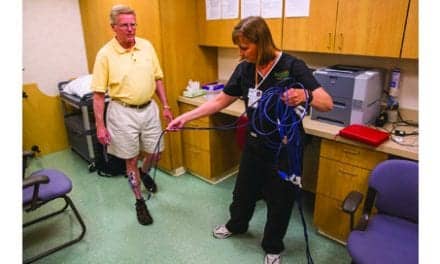A literature review published in the Journal of the American Academy of Orthopaedic Surgeons explores the treatment options for patients who experience an Achilles tendon tear.
The review suggests that minimally invasive surgery or nonsurgical bracing with a removable boot were effective treatments. However, the injection of platelet rich plasma (PRP) at the injury site was not effective.
In the study, the use of an adjustable, removable boot that allows for movement and exercise is called “functional rehabilitation,” and according to the researchers in their review it provides a lower risk for infection and re-rupture than immobilization with a hard cast.
Surgical repair of an Achilles tendon tear, which also has evolved to minimize the risk of complication and infection, may still be optimal for high-performance athletes, or patients in physically demanding professions, states the media release, from the American Academy of Orthopaedic Surgeons.
“The treatment of acute Achilles tendon ruptures has evolved over the last decade demonstrating improved outcomes with functional rehabilitation compared to prolonged cast immobilization,” says Anish Kadakia, MD, associate professor of orthopaedic surgery at Northwestern University-Feinberg School of Medicine, and lead author of the article.
“Given the high demands of the athlete, minimally invasive surgical treatment should be considered over non-operative management as it minimizes the soft tissue complications while maximizing the power and strength of the patient,” Kadakia adds.
According to the review, per the release, recent research found no difference in re-rupture rates between functional rehabilitation and minimally invasive surgical repair; and there were no significant long-term differences in ankle range of motion, strength, calf circumference, or functional outcome scores between patients undergoing functional rehabilitation and those with surgical treatment.
In addition, the review suggests that functional rehabilitation resulted in faster return to mobility and work compared with casting for 8 weeks; and surgical treatment was associated with return to work up to 19 days earlier than nonsurgical treatment.
Furthermore, per the review, patients undergoing surgery had a small, yet statistically significant increase in plantar flexion strength at 1 and 2 years after surgical repair, which may be advantageous for high-performance athletes.
Finally, per the release, no existing research supports the use of PRP injections for Achilles tendon tears, as studies, to date, found no improvement in functional outcomes with use. However, the use of bone marrow-derived stem cells have shown promising results in animal studies.
[Source(s): American Academy of Orthopaedic Surgeons, Science Daily]





